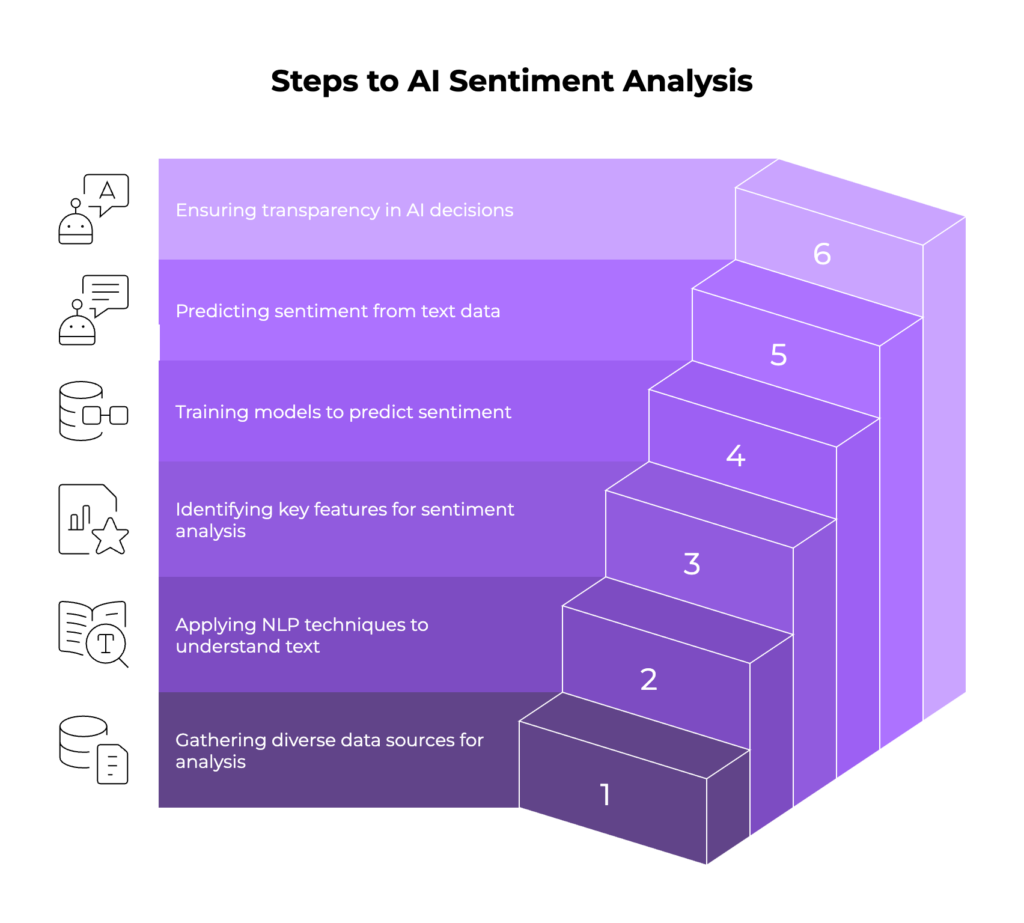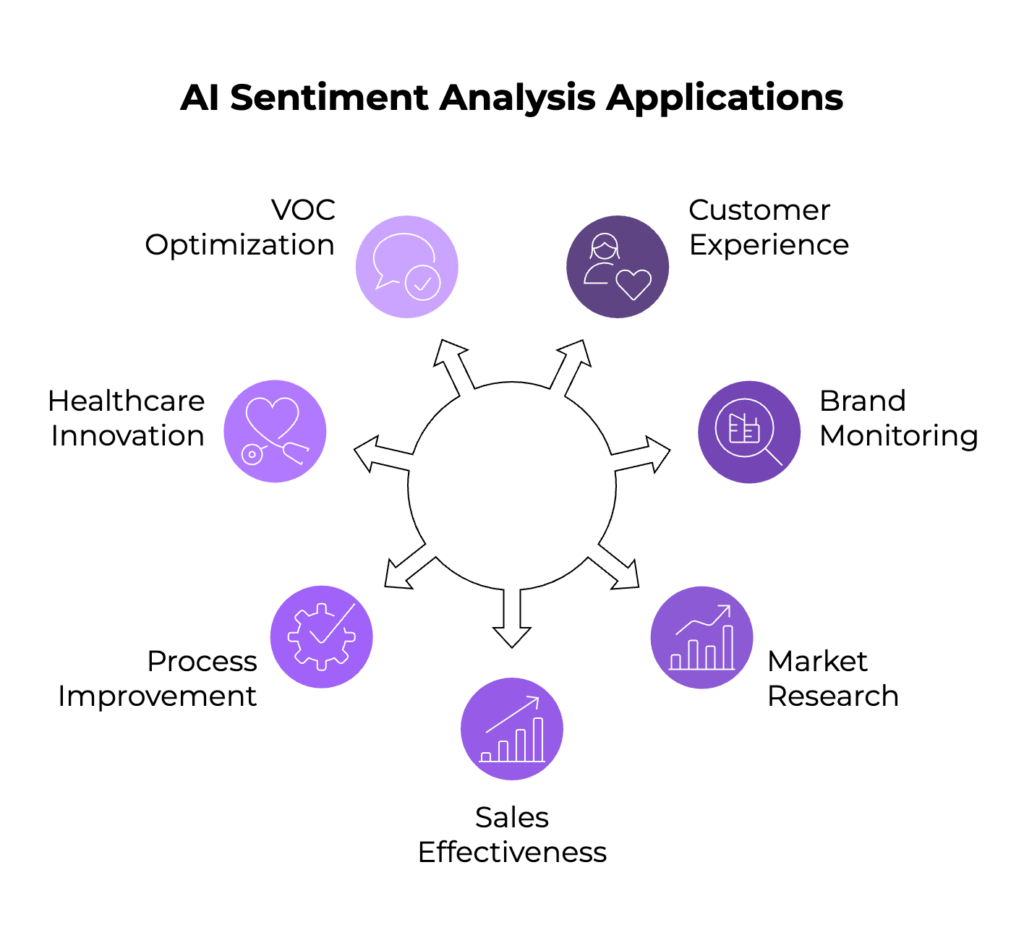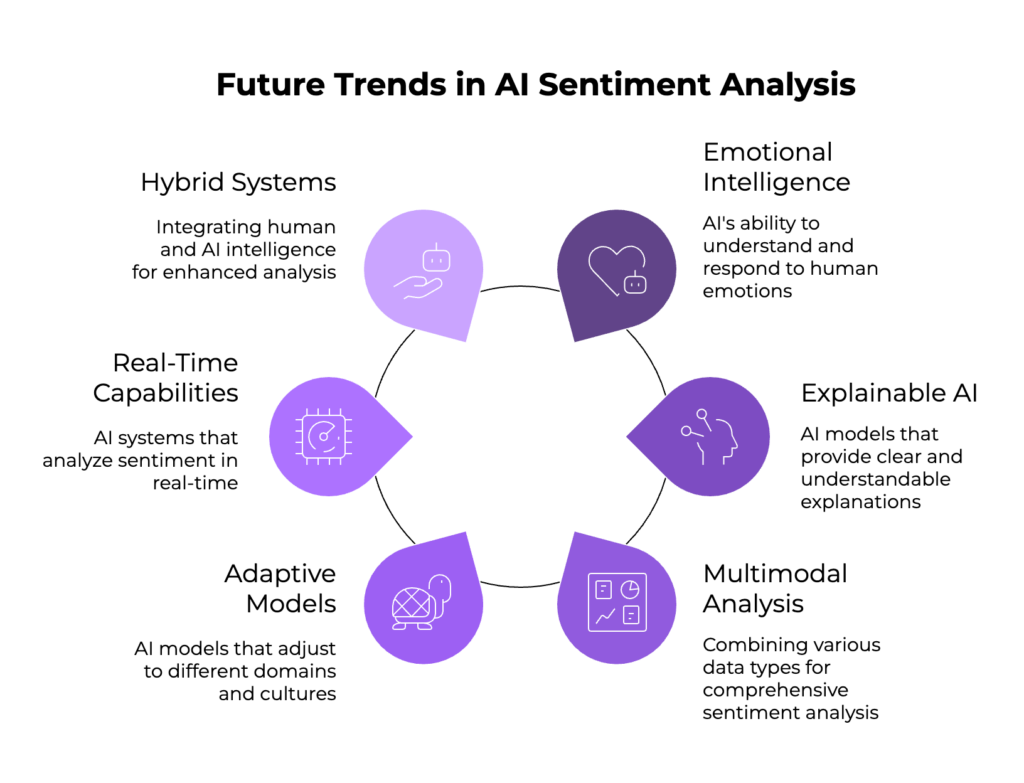Discover how AI sentiment analysis is revolutionizing business in 2025. Explore the latest stats, market trends, and expert insights on how artificial intelligence deciphers customer emotions to drive smarter decisions and better experiences.
We’ve all done it.
Posted a review, fired off a customer complaint, or praised a brand online.
Now multiply that by millions. That’s what businesses are dealing with daily; an avalanche of text, voice, and video feedback. Hidden inside all this is customer emotion, waiting to be understood.
AI Sentiment Analysis (also called opinion mining or emotion AI) is how companies make sense of it all. It uses Natural Language Processing (NLP) and machine learning to classify what people are really feeling about your brand- positive, negative, or neutral.
More advanced models even go further, picking up on emotions like joy, anger, or frustration.Here’s why this matters: nearly 80% of all business data is unstructured: tweets, chats, call logs, reviews.
Traditional analytics don’t work here.
AI, on the other hand, doesn’t just read the words. It understands meaning, context, and even tone of voice. AI can catch sarcasm. It can detect intent. It can process millions of interactions in seconds.
In this blog, let’s understand what AI sentiment analysis here, how it works, its use cases and how interpreting it right can help you brand succeed.
What is AI Sentiment Analysis?
At its core, AI Sentiment Analysis, also known as opinion mining or emotion AI, is a branch of natural language processing (NLP) and machine learning dedicated to identifying and categorizing subjective information expressed in text or spoken language.
It involves analyzing language to determine whether the sentiment conveyed is positive, negative, or neutral, and, increasingly, to detect emotions such as happiness, anger, sadness, or frustration.
“Machines don’t feel, but they can learn to recognize and respond to human emotions.” — Rosalind Picard, Professor at MIT
The technology processes vast amounts of unstructured data from social media posts, customer reviews, emails, and voice calls that generally represent about 80% of all available data in businesses. Since this data doesn’t follow a structured format, traditional analytics falter in pulling actionable insights.
AI Sentiment Analysis overcomes this by leveraging algorithms that consider semantics (meaning of words and phrases), context (such as sarcasm or negation), and even paralinguistic cues like tone changes or laughter in voice data. In fact, Artificial neural networks achieve 85% accuracy in identifying sentiment, outperforming other methods.
This allows for the classification of opinions into meaningful categories at scale — an impossible feat to achieve manually.

Some key features of AI Sentiment Analysis include:
- Polarity Detection: Classifying opinions into positive, negative, or neutral sentiments.
- Emotion Detection: Pinpointing specific emotions beyond polarity, such as anger or happiness.
- Intent Identification: Understanding the underlying purpose or reason behind a statement.
- Aspect-Based Analysis: Breaking down sentiments related to particular features or aspects of a product or service.
By automating the analysis of customer sentiment, businesses gain a real-time pulse on public opinion, enabling faster response, better decision-making, and enhanced customer experiences. This capability is critical as modern commerce depends less on self-reported surveys and more on continuous, natural customer feedback through various digital channels.
Now let’s explore why this technology is so crucial to modern businesses.
Why is AI Sentiment Analysis Important?

Think feedback is just noise? Think again. Buried in those rants and raves is your next growth opportunity or PR disaster. Sentiment analysis separates signal from static.
Many organizations underestimate the value locked within unstructured customer feedback. Yet, understanding sentiment is pivotal for numerous reasons:
Unlocking the Voice of the Customer
AI Sentiment Analysis reveals genuine customer emotions and perceptions from interactions that traditional quantitative data cannot capture. Unlike surveys, which yield polarized or limited responses, sentiment scoring analyzes every interaction, providing a continuous and broad dataset for meaningful insights.
Driving Customer Satisfaction and Loyalty
Research shows that companies using real-time sentiment analysis are 2.4 times more likely to exceed customer satisfaction targets.
AI-powered sentiment scoring identifies issues driving dissatisfaction and detects opportunities where companies excel, enabling targeted improvements and personalized engagements.
Monitoring Brand Health and Market Perception
By analyzing social media chatter, product reviews, and public discussions, organizations can get a 360-degree view of brand perception in real-time. Sudden spikes in mentions around an event can be broken down by sentiment to distinguish whether public reaction is favorable or adverse, allowing marketing teams to tailor messaging or crisis response.
Enhancing Customer Support and Agent Performance
Sentiment analysis helps score agent performance objectively by detecting emotions during interactions and can provide real-time coaching guidance to agents to improve conversations dynamically—thereby improving customer experience and employee training.
Businesses leveraging advanced sentiment analysis tools report a 25% increase in customer retention by improving conversation quality.
Supporting Business Intelligence and Market Research
Going beyond quantitative metrics, sentiment provides qualitative insights into customer preferences, pain points, and attitudes toward products or services, informing product development and strategic planning with deep consumer-centric knowledge.
In fact, Retail and healthcare are among the largest end-users of AI sentiment analysis tools for this reason.
The importance of sentiment analysis is such that businesses equipped with this technology enjoy competitive advantages in understanding nuanced customer behaviors, optimizing processes, and proactively managing customer relationships.
Understanding its importance is one thing. But how does it actually work under the hood?
How AI Sentiment Analysis Works

It might feel like magic, but it’s all machine. This section breaks down how AI reads language, picks up on tone, and detects emotion even when humans can’t agree. AI Sentiment Analysis combines several sophisticated technologies and processes:
1. Data Collection
The process starts with gathering text or voice data from various sources, including social media platforms, emails, chat logs, phone calls, surveys, and review sites. This unstructured data is huge but noisy, requiring substantial preprocessing.
2. Natural Language Processing (NLP)
NLP techniques parse the text to tokenize sentences, tag parts of speech, identify named entities, and understand syntax. The nuances of language means the AI must understand multiple linguistic layers—from literally identifying words to grasping semantics and context such as negations, sarcasm, or intensifiers. Transformer-based models like RoBERTa and ChatGPT-4, trained on massive datasets (e.g., over 120 million tweets), are now standard for AI-powered sentiment analysis.
3. Feature Extraction
Relevant features are extracted such as keywords, emoticons, punctuation, degree words (“very,” “slightly”), n-gram sequences, and even phonetic features in speech like pitch or tone. These features feed into machine learning models to correlate inputs with sentiment outputs.
4. Machine Learning and Deep Learning Models
Early sentiment analysis models leveraged lexicon-based methods (using prebuilt sentiment dictionaries) or shallow machine learning classifiers like Naive Bayes, K-Nearest Neighbors (KNN), or Support Vector Machines (SVM). These models were often limited by the need for manual feature engineering and domain-specific dictionaries.
Modern approaches utilize Deep Neural Networks (DNNs) such as Recurrent Neural Networks (RNNs), Long Short-Term Memory (LSTM), Bidirectional LSTM (BiLSTM), Gated Recurrent Units (GRU), and Convolutional Neural Networks (CNN).
These models learn to capture sequential and contextual dependencies within text to enhance accuracy. The rise of Transformer architectures like BERT and GPT-series has further revolutionized the field by enabling context-aware embeddings that represent words dynamically depending on their surrounding context.
5. Sentiment Prediction
After the model processes the input features, it outputs sentiment classifications on various scales—binary (positive/negative), fine-grained (very positive to very negative), or multilabel emotion categories. Aspect-based and intent analysis dive deeper into sentiment related to specific features or underlying customer goals.
Deep learning models such as LSTM achieved an accuracy of 83.3% in sentiment classification tasks, outperforming traditional models like SVM and Naive Bayes.
6. Explainability and Transparency
A crucial layer in AI sentiment analysis systems is explainable AI (XAI), which aims to present an interpretable rationale behind predictions. Techniques like attention mechanisms, LIME (Local Interpretable Model-Agnostic Explanations), SHAP (SHapley Additive exPlanations), and feature importance mapping provide transparency around which words or phrases influenced sentiment outcomes. This is particularly important in sensitive fields like healthcare and finance.
Once we understand the mechanics, it’s time to look at the different flavors of sentiment analysis and what each one can unlock.
Key Types of AI Sentiment Analysis

Not all sentiment is created equal. From detecting raw emotions to analyzing product-specific gripes, AI sentiment analysis comes in many forms each with a unique job.
Within the umbrella of AI Sentiment Analysis, several distinct but interrelated subtypes exist, each unlocking different insights:
Fine-Grained Sentiment Analysis
Also called polarity detection, this method assigns sentiment values along a continuum such as very positive, positive, neutral, negative, very negative. This granularity aids nuanced understanding beyond simple like/dislike.
Emotion Detection
Emotion detection identifies specific feelings such as joy, anger, sadness, fear, surprise, etc. This is valuable in gauging customer emotional states, detecting frustration or enthusiasm in support calls, and influencing real-time responses.
Techniques here use NLP-based semantic cues or classification algorithms trained on annotated emotional datasets, often incorporating emoticons and slang to improve detection accuracy.
Aspect-Based Sentiment Analysis (ABSA)
ABSA zooms in on particular product or service attributes within text, assessing sentiment specific to these aspects—for example, battery life of a phone, customer service response, or food quality. This granular perspective enables businesses to pinpoint exact strengths and weaknesses in their offerings.
Intent Analysis
Often coupled with sentiment analysis, intent detection digs into the underlying motives behind text, such as buying intent, complaint, query, or appreciation. Understanding intent helps tailor automated workflows in customer service or marketing, such as routing inquiries or offering targeted promotions.
Multimodal Sentiment Analysis
Integrating multiple data modalities—text, voice tone, facial expressions, gestures—this approach goes beyond words to deeply interpret customer emotions, beneficial for call centers and video-based feedback.
Now that we’ve mapped the types, let’s bring them to life through real-world use cases.
Common Use Cases and Applications of AI Sentiment Analysis

From defusing angry customers to informing product design, sentiment insights power decisions across industries. Here’s where the technology gets real.
The transformative potential of AI Sentiment Analysis spans across multiple industries and use cases:
Customer Experience and Support
By scanning all customer interactions, sentiment models identify clients exhibiting dissatisfaction or frustration, allowing proactive outreach. Real-time sentiment scoring during calls provides agents with cues and coaching prompts to handle conversations more effectively.
Brand Monitoring and Reputation Management
Sentiment analysis continuously monitors social media mentions, reviews, and news coverage to detect shifts in public opinion and emerging issues, helping PR teams quickly respond and manage crises.
Market Research and Product Development
Companies analyze consumer opinions on features, quality, pricing, and support to guide product enhancements and strategic positioning based on authentic voice-of-the-customer insights.
Sales Effectiveness
Sentiment around sales processes, pitch quality, and objections can be analyzed to refine sales strategies and training programs, boosting conversion rates.
Process Improvement
Identifying sentiment trends related to operational inefficiencies reveals root causes behind negative experiences, enabling targeted process reengineering.
Healthcare and Social Innovation
Sentiment models are applied in medical patient forums for monitoring public health sentiment or in community programs to assess engagement and impact, as demonstrated through comparative AI-human analysis of community transcripts (Crave program study).
Voice of the Customer (VOC) and Survey Optimization
Sentiment from unstructured feedback supplements traditional survey methods, enabling adaptive surveys deployed post-negative interactions, increasing response rates and closing feedback loops more efficiently.
So what’s in it for you? Let’s break down the biggest business benefits of using AI for sentiment analysis.
Benefits of Using AI for Sentiment Analysis
Speed, scale, and clarity. These aren’t just perks—they’re game-changers. AI turns the messy flood of feedback into a stream of actionable insight.
Leveraging AI allows organizations to harness the vast volumes of textual and speech data impossible to manually parse:
- Scale and Speed: AI can analyze millions of interactions in real-time across multiple channels.
- Depth of Insight: Detect subtle or emerging sentiment trends and emotions, not captured in numeric surveys.
- Objective Measurement: Removes human bias inherent in manual coding, providing consistent and reproducible results.
- Cost Efficiency: Automates laborious qualitative data analysis, enabling reallocation of resources.
- Real-Time Guidance: Provides live coaching and intervention opportunities in customer-facing roles.
- Adaptive Data Collection: Informs the design and targeting of surveys and outreach campaigns.
- Strategic Advantage: Enhances competitive intelligence and customer-centric decision-making.
For instance, real deployments have demonstrated substantial reductions in average handling time, improvements in customer satisfaction scores, and revenue uplifts following AI integration into sentiment workflows.
But even game-changers have blind spots. Let’s get honest about the challenges still holding AI sentiment analysis back.
Challenges and Limitations of AI Sentiment Analysis
Sarcasm, culture, and context—humans are complex, and AI is still learning. This section dives into the sticky parts machines haven’t mastered (yet).
Despite remarkable advances, AI sentiment models face inherent challenges:
- Ambiguity in Language and Context: AI struggles to grasp sarcasm, irony, metaphor, idiomatic expressions, and cultural nuances. This results in classification errors, especially for short, ambiguous statements.
- Differentiating Complex Social Constructs: Studies comparing AI models (Claude, Bing) to human annotators on community program transcripts revealed frequent confusion distinguishing between Social, Human, Cultural, and Political capital themes. Even humans have difficulty consistently labeling such multi-dimensional content, indicating the intrinsic challenge.
- Limited Domain Adaptation: Models trained on general datasets may underperform on domain-specific vocabulary or slang unless extensively fine-tuned.
- Model Transparency: Deep learning models, particularly transformers, often operate as “black boxes” with little inherent explainability. This poses challenges for decision justification and regulatory compliance.
- Data Bias and Annotation Subjectivity: Sentiment labeling is subjective, introducing variance in training data, which AI systems may propagate.
- Multilingual and Multimodal Limitations: Most models excel primarily in English and require adaptation for other languages or incorporating voice, facial expressions alongside text for holistic sentiment understanding.
Despite the hurdles, the tools are evolving fast. Let’s look at what’s already on the market—and what might be right for you.
Popular AI Sentiment Analysis Tools and Platforms
From Google to open-source to industry-specific platforms, sentiment analysis tools vary wildly. Here’s how they stack up.
The market offers various AI platforms with sentiment analysis capabilities, catering to different scales and needs:
- Google Cloud Natural Language API: Offers sentiment and entity analysis with language support and scalability.
- IBM Watson Natural Language Understanding: Focuses on sentiment, emotion analysis, and keywords extraction.
- Microsoft Azure Text Analytics: Provides multi-language sentiment analysis and opinion mining.
- Amazon Comprehend: Offers domain-specific sentiment detection and custom classification models.
- Open-Source Libraries: Such as Hugging Face Transformers, offering pre-trained models like BERT fine-tuned for sentiment tasks.
- NICE Enlighten AI: Enterprise solution delivering comprehensive customer sentiment measurement with agent coaching and real-time guidance.
- Social Media Monitoring Tools: Brandwatch, Sprout Social, which incorporate sentiment analysis for brand reputation.
- Specialized AI Models: Claude (Anthropic), Bing (Microsoft), OpenAI GPT variants serve emerging research and application domains.
Choosing tools depends on data volume, language needs, model explainability demands, and integration requirements.
Once you pick your tools, it’s all about implementation. Next up: best practices to make your sentiment strategy stick.
Best Practices and Tips for Implementing AI Sentiment Analysis

Buying the tech is easy. Using it well? That’s the difference between real insight and dashboard noise. Here’s how to do it right.
Successful deployment hinges on thoughtful strategy:
- Define Clear Objectives: Know what you want to measure (customer satisfaction, product feedback, intent detection).
- Use Diverse Data Sources: Combine reviews, social media, voice interactions, and surveys for comprehensive views.
- Invest in Quality Training Data: Annotate data carefully, accounting for domain-specific language and cultural nuances.
- Incorporate Explainability: Use XAI techniques to understand model decisions and build user trust.
- Continuously Monitor Model Performance: Regularly assess AI against human benchmarks, especially for complex language constructs.
- Leverage Aspect-Based and Intent Analysis: For more actionable insights and targeted responses.
- Enable Real-Time Insights: Integrate sentiment scoring into live customer interactions for proactive engagement.
- Blend AI with Human Oversight: Use hybrid approaches to check AI misclassifications, especially for ambiguous or sensitive content.
- Adapt Surveys Based on Sentiment: Deploy targeted outreach following negative sentiment interactions to close feedback loops.
- Plan for Multilingual and Multimodal Scalability: Include provisions for voice, video, and international markets.
You’ve got the tech and the tactics—so what’s next? Let’s peek into the future of AI sentiment analysis.
Future Trends in AI Sentiment Analysis

The AI sentiment analysis tool market is expected to grow at a CAGR of 18.9% from 2026 to 2033, driven by increased demand for data-driven insights in business decision-making, especially in marketing, customer service, and product development.
The next frontier of sentiment analysis goes beyond text and tone. Think facial expressions, predictive emotions, and AI that “feels” human. The future’s not far.
Sentiment analysis remains a dynamic research and application area with promising advances:
- Emotional Intelligence in AI: Recent studies demonstrate that large language models (LLMs) such as GPT-4 can be enhanced by emotional prompts, boosting accuracy in recognizing subtle emotional cues and empathy-like reasoning, paving the way for more human-like sentiment understanding.
- Explainable and Trustworthy AI: The growing importance of explainability has accelerated research on interpretable models that balance high accuracy with transparency, reinforcing trust, ethics, and regulatory compliance.
- Multimodal Sentiment Analysis: Future systems will combine text, speech prosody, facial expressions, and physiological signals for comprehensive affective computing applications in healthcare, customer service, and social robotics.
- Domain and Culture Adaptive Models: Efforts to adapt sentiment models dynamically to varied domains, languages, dialects, and cultural contexts will enhance global applicability and reduce biases.
- Real-Time, Predictive, and Prescriptive Capabilities: Sentiment analysis will evolve to not only interpret past and present feedback but predict customer behaviors, churn risks, and market shifts, supporting proactive interventions.
- Hybrid Human-AI Systems: Given current AI limitations, the best results come from integrated human-AI workflows where machines handle scale and humans provide nuanced judgment, especially in complex social and cultural classification tasks.
As we close this guide, let’s bring it all together—why sentiment matters, what AI can do, and how to use it to your brand’s advantage.
Conclusion
AI Sentiment Analysis stands at the forefront of transforming how organizations capture and interpret the emotional pulse of their customers.
As sentiment analysis technologies continue to mature empowered by advances in deep learning and emotional intelligence, they offer unprecedented opportunity for businesses to become truly customer-centric, anticipate needs, and foster lasting loyalty.
For organizations striving to unlock the latent power of their unstructured data, investing in AI Sentiment Analysis is no longer optional; it is imperative to remain competitive in an experience-driven market.